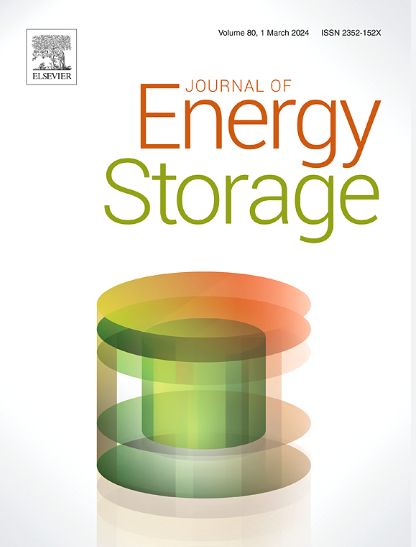高性能钒氧化还原液流电池用zif改性定制多尺度孔n掺杂石墨毡
IF 8.9
2区 工程技术
Q1 ENERGY & FUELS
引用次数: 0
摘要
在多孔电极中实现高电化学活性和局部传质能力是提高钒氧化还原液流电池性能的关键。在本研究中,通过在石墨毡上附着沸石咪唑酸骨架-8并进行退火,制备了具有最佳孔径可调分布的氮掺杂分层多孔石墨毡电极。在这种定制的多孔结构中构建的宏/中尺度孔隙促进了活性物质从体溶液扩散到电极-电解质界面,增加了活性位点的可及性。同时,纳米级表面大量含有官能团和缺陷的微孔可以增加有效活性位点的数量和催化活性,从而提高反应动力学。实验表明,合理设计的电极在高电流密度下实现了优异的电池性能。它在300 mA cm - 2和400 mA cm - 2时的能量效率分别为83.7%和79.4%,峰值功率密度为1215.8 mW cm - 2。然而,它甚至可以使电池在500毫安厘米−2下工作,能量效率达到74.8%。值得注意的是,它的长期稳定性也得到了证明,在300 mA cm−2下稳定循环超过1000次,每循环的能量效率衰减率为0.00667%。为满足未来钒氧化还原液流电池对高功率、高效率的要求,提供了一种可行的电极设计方法。本文章由计算机程序翻译,如有差异,请以英文原文为准。
ZIF-modified tailored multiscale-pore N-doped graphite felt for high performance vanadium redox flow batteries
Achieving both high electrochemical activity and local mass transport ability in porous electrode is critical to improve the performance of vanadium redox flow battery. In this work, a nitrogen-doped hierarchical multi-porous graphite felt electrode with optimal tunable pore size distribution is prepared by attachment of zeolitic imidazolate framework-8 and subsequent annealing on graphite felt. The constructed macro/meso-scale pores in this tailored multi-porous structure facilitates the diffusion of active species from bulk solution to the electrode-electrolyte interface, increasing the accessibility of active sites. Meanwhile, numerous micropores containing functional groups and defects on nanoscale surface can boost the number of effective active sites and catalytic activity, thus enhancing the reaction kinetics. The tests exhibit that the rationally designed electrode realizes outstanding battery performance at high current densities. It achieves an energy efficiency of 83.7 % at 300 mA cm−2 and 79.4 % at 400 mA cm−2, and a peak power density of 1215.8 mW cm−2. Nevertheless, it even enables the battery operation at 500 mA cm−2 with a considerable energy efficiency of 74.8 %. Remarkably, its long-term stability was also proved by stably cycling over 1000 cycles at 300 mA cm−2 with a low energy efficiency decay rate of 0.00667 % per cycle. This work provides a feasible method for electrode design to meet future vanadium redox flow battery requirements for high power and efficiency.
求助全文
通过发布文献求助,成功后即可免费获取论文全文。
去求助
来源期刊

Journal of energy storage
Energy-Renewable Energy, Sustainability and the Environment
CiteScore
11.80
自引率
24.50%
发文量
2262
审稿时长
69 days
期刊介绍:
Journal of energy storage focusses on all aspects of energy storage, in particular systems integration, electric grid integration, modelling and analysis, novel energy storage technologies, sizing and management strategies, business models for operation of storage systems and energy storage developments worldwide.
 求助内容:
求助内容: 应助结果提醒方式:
应助结果提醒方式:


